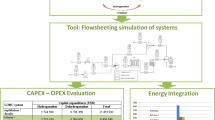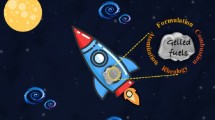Abstract
Polyoxymethylene dimethyl ethers (abbreviated as PODEn or OMEn) is a type of e-fuel with the structure CH3O(CH2O)nCH3. The carbon neutrality throughout its life cycle makes PODEn an attractive alternative to fossil fuels. Burning PODEn instead of fossil fuel can significantly reduce carbon monoxide, carbon dioxide, hydrocarbon, and especially particulate matter emissions. The heat capacity, surface tension, thermal conductivity, latent heat of vaporization, density, viscosity, and vapor pressure from room temperature to the critical point of a fuel are required for its spray simulations. In this study, for PODEn with 1 ≤ n ≤ 6, the isobaric heat capacity, surface tension, and thermal conductivity were measured with the sapphire method, pendant drop method, and transient plane source method, respectively, around room temperature and at atmospheric pressure. Furthermore, relevant calculation methods extended all the physical properties mentioned above from 298.15 K to the critical points. The calculation results were verified against and regressed with the experimental data obtained from previous literature or the experiments conducted in this study. The results of this study can greatly reduce the uncertainty in the PODEn spray simulations due to the absence of physical property data.










Similar content being viewed by others
References
European Union, European climate law (2021). https://climate.ec.europa.eu/eu-action/european-green-deal/european-climate-law_en. Accessed 12 January 2023
United States Department of State, THE LONG-TERM STRATEGY OF THE UNITED STATES-Pathways to Net-Zero Greenhouse Gas Emissions by 2050 (2021). https://www.state.gov/tackling-the-climate-crisis-together/longtermstrategy-3/. Accessed 12 January 2023
Ministry of Foreign Affairs of the People's Republic of China, Statement by Xi Jinping President of the People's Republic of China at the general debate of the 75th session of the United Nations General Assembly (2020). https://www.fmprc.gov.cn/mfa_eng/wjdt_665385/zyjh_665391/202009/t20200922_678904.html. Accessed 12 January 2023.
S. Deutz, D. Bongartz, B. Heuser, A. Kätelhön, L. Schulze-Langenhorst, A. Omari, M. Walters, J. Klankermayer, W. Leitner, A. Mitsos, S. Pischinger, A. Bardow, Energy Environ. Sci. 11, 331 (2018). https://doi.org/10.1039/c7ee01657c
J. Burger, M. Siegert, E. Ströfer, H. Hasse, Fuel 89, 3315 (2010). https://doi.org/10.1016/j.fuel.2010.05.014
M. Natarajan, E.A. Frame, D.W. Naegeli, T. Asmus, W. Clark, J. Garbak, A. Manuel, D. González, E. Liney, W. Piel, J.P. Wallace, SAE Technical Paper 2001-01-3631, (2001). https://doi.org/10.4271/2001-01-3631
C.K. Westbrook, W.J. Pitz, H.J. Curran, J. Phys. Chem. A 110, 6912 (2006). https://doi.org/10.1021/jp056362g
Y. Ren, Z. Huang, H. Miao, Y. Di, D. Jiang, K. Zeng, B. Liu, X. Wang, Fuel 87, 2691 (2008). https://doi.org/10.1016/j.fuel.2008.02.017
J. Liu, H. Wang, Y. Li, Z. Zheng, Z. Xue, H. Shang, M. Yao, Fuel 177, 206 (2016). https://doi.org/10.1016/j.fuel.2016.03.019
H. Liu, Z. Wang, J. Wang, X. He, Y. Zheng, Q. Tang, J. Wang, Energy 88, 793 (2015). https://doi.org/10.1016/j.energy.2015.05.088
Z. Zheng, W. Liu, H. Liu, L. Feng, Y. Cui, S. Zhang, M. Yao, Sci. China: Technol. Sci. 64, 1611 (2021). https://doi.org/10.1007/s11431-020-1764-y
J.V. Pastor, A. García, C. Micó, F. Lewiski, Combust. Flame 230, 111437 (2021). https://doi.org/10.1016/j.combustflame.2021.111437
L. Lautenschütz, D. Oestreich, P. Seidenspinner, U. Arnold, E. Dinjus, J. Sauer, Fuel 173, 129 (2016). https://doi.org/10.1016/j.fuel.2016.01.060
J. Qi, Y. Hu, J. Niu, W. Ma, S. Jiang, Y. Wang, X. Zhang, Y. Jiang, Fuel 234, 135 (2018). https://doi.org/10.1016/j.fuel.2018.07.007
L. Tong, H. Wang, Z. Zheng, R. Reitz, M. Yao, Fuel 181, 878 (2016). https://doi.org/10.1016/j.fuel.2016.05.037
H. Duan, M. Jia, Y. Chang, H. Liu, Fuel 256, 115907 (2019). https://doi.org/10.1016/j.fuel.2019.115907
H. Duan, M. Jia, J. Bai, Y. Li, Int. J. Engine Res. (2021). https://doi.org/10.1177/14680874211013667
H. Duan, M. Jia, Y. Li, T. Wang, Fuel 298, 120838 (2021). https://doi.org/10.1016/j.fuel.2021.120838
J. Pan, J.T. Wu, Z.G. Liu, X.G. Jin, Int. J. Thermophys. 25, 701 (2004). https://doi.org/10.1023/B:IJOT.0000034233.54418.d7
J.T. Wu, Z.Y. Xu, Z.G. Liu, B. Wang, J. Chem. Eng. Data 50, 966 (2005). https://doi.org/10.1021/je049559v
O. Borodin, G.D. Smith, J. Phys. Chem. B 110, 6279 (2006). https://doi.org/10.1021/jp055079e
X. Wang, J. Pan, J. Wu, Z. Liu, J. Chem. Eng. Data 51, 1394 (2006). https://doi.org/10.1021/je060097q
Y. Ren, F.K. Wang, Z.H. Huang, Energy Fuels 21, 1628 (2007). https://doi.org/10.1021/ef070065o
P. Zheng, X. Meng, J. Wu, Z. Liu, Int. J. Thermophys. 29, 1244 (2008). https://doi.org/10.1007/s10765-008-0503-0
F. Comelli, S. Ottani, R. Francesconi, C. Castellari, J. Chem. Eng. Data 47, 1226 (2002). https://doi.org/10.1021/je0255224
F. Wang, J. Wu, Z. Liu, Energy Fuels 20, 2471 (2006). https://doi.org/10.1021/ef060231c
R.H. Boyd, J. Polym. Sci. 50, 133 (1961). https://doi.org/10.1002/pol.1961.1205015316
M.H.H. Fechter, P. Haspel, C. Hasse, A.S. Braeuer, Fuel 303, 121274 (2021). https://doi.org/10.1016/j.fuel.2021.121274
M. Kang, H. Song, F. Jin, J. Chen, J. Fuel Chem. Technol. 45, 837 (2017). https://doi.org/10.1016/s1872-5813(17)30040-3
Q. Liu, X. Zhang, B. Ma, Y. Lin, J. Chem. Thermodyn. 113, 151 (2017). https://doi.org/10.1016/j.jct.2017.06.002
T. He, Z. Wang, X. You, H. Liu, Y. Wang, X. Li, X. He, Fuel 212, 223 (2018). https://doi.org/10.1016/j.fuel.2017.09.080
B. Li, K.H. Yoo, Z. Wang, A.L. Boehman, J. Wang, Energy Fuels 33, 11841 (2019). https://doi.org/10.1021/acs.energyfuels.9b02013
Q. Lin, K.L. Tay, D. Zhou, W. Yang, Energy Convers. Manage. 185, 35 (2019). https://doi.org/10.1016/j.enconman.2019.02.007
D. Lv, Y. Chen, Y. Chen, X. Guo, H. Chen, H. Huang, Energy Convers. Manage. 199, 112070 (2019). https://doi.org/10.1016/j.enconman.2019.112070
J. Liu, (Tianjin University, Tianjin, 2018)
J. Peleteiro, J. Troncoso, D. González-Salgado, J.L. Valencia, C.A. Cerdeiriña, L. Romaní, Int. J. Thermophys. 25, 787 (2004). https://doi.org/10.1023/B:IJOT.0000034237.54486.bb
E. Zorębski, P. Góralski, B. Godula, M. Zorębski, J. Chem. Thermodyn. 68, 145 (2014). https://doi.org/10.1016/j.jct.2013.08.033
A. Mejía, M. Cartes, H. Segura, J. Chem. Thermodyn. 43, 1395 (2011). https://doi.org/10.1016/j.jct.2011.04.005
H. Jiang, Y. Zhao, J. Wang, F. Zhao, R. Liu, Y. Hu, J. Chem. Thermodyn. 64, 1 (2013). https://doi.org/10.1016/j.jct.2013.04.015
S.E. Gustafsson, Rev. Sci. Instrum. 62, 797 (1991). https://doi.org/10.1063/1.1142087
M.J. Assael, E.A. Sykioti, M.L. Huber, R.A. Perkins, J. Phys. Chem. Ref. Data 123, 174503 (2005). https://doi.org/10.1063/1.4797368
M.J. Assael, E. Charitidou, C.A. Nieto de Castro, Int. J. Thermophys. 9, 813 (1988). https://doi.org/10.1007/bf00503247
R.C. Reid, J.M. Prausnitz, B.E. Poling, The Properties of Gases & Liquids, 4th edn. (McGraw-Hill, New York, 1987)
F. Dai, K. Xin, Y. Song, M. Shi, Y. Yu, Q. Li, Fluid Phase Equilib. 409, 466 (2016). https://doi.org/10.1016/j.fluid.2015.11.009
Y. Song, J.Q. Li, H. Zhang, X. Li, J. Ding, X. Sun, Y. Lin, Fluid Phase Equilib. 377, 33 (2014). https://doi.org/10.1016/j.fluid.2014.06.019
A. Kulkarni, E.J. Garcia, A. Damone, M. Schappals, S. Stephan, M. Kohns, H. Hasse, J. Chem. Theory Comput. 16, 2517 (2020). https://doi.org/10.1021/acs.jctc.9b01106
D.M. McEachern, J.E. Kilpatrick, J. Chem. Phys. 41, 3127 (1964). https://doi.org/10.1063/1.1725685
K. Zhang, J.T. Wu, Z.G. Liu, J. Chem. Eng. Data 51, 1743 (2006). https://doi.org/10.1021/je0601614
J.A. Dean, Lange’s Handbook of Chemistry, 15th edn. (McGraw-Hill, New York, 1999)
D. Sanfilippo, R. Patrini, M. Marchionna, Use of an oxygenated product as a substitute of gas oil in diesel engines (2007). https://patents.google.com/patent/US7235113B2
Funding
The research leading to these results received funding from the National Key Research and Development Program of China under Grant Agreement No. 2022YFE0199600.
Author information
Authors and Affiliations
Contributions
HL wrote the main manuscript text and finished the main work of this study, including experiments, calculations, data analysis, and literature search. As the supervisor of HL, MJ provided key guidance on the related work and revised the manuscript.
Corresponding author
Ethics declarations
Conflict of interest
The authors have no competing interests to declare that are relevant to the content of this article.
Additional information
Publisher's Note
Springer Nature remains neutral with regard to jurisdictional claims in published maps and institutional affiliations.
Supplementary Information
Below is the link to the electronic supplementary material.
Rights and permissions
Springer Nature or its licensor (e.g. a society or other partner) holds exclusive rights to this article under a publishing agreement with the author(s) or other rightsholder(s); author self-archiving of the accepted manuscript version of this article is solely governed by the terms of such publishing agreement and applicable law.
About this article
Cite this article
Li, H., Jia, M. Measurements and Derivation of the Spray Simulation Required Physical Properties of Polyoxymethylene Dimethyl Ethers (PODEn). Int J Thermophys 44, 41 (2023). https://doi.org/10.1007/s10765-022-03147-1
Received:
Accepted:
Published:
DOI: https://doi.org/10.1007/s10765-022-03147-1




